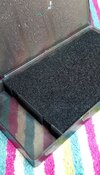Hi Dave
Not the answer you are going to want, but basically you make it as wet as you want it to be

I have a palette made by Redgrass that has a sponge as it’s water reservoir. I usually fill the palette and sponge in the sink, allow it to soak for a minute or two, then pour off the excess. Once I’ve done that I put the top sheet on and when that’s hydrated (it goes on smooth, curls up as it starts to hydrate, then flattens out again when it’s right) smooth it out. Try to get as many of the wrinkles out as you can, because air trapped in wrinkles under the top sheet can stop it working like it should.
Initially I find the palette too wet at the start, sometimes leading to certain colours becoming over diluted (reds in part seem prone to this), but as the water evaporates from the sponge in use it hits the “sweet spot” I like. Once it’s there I occasionally add a dropper pipette or two of water to the sponge around the edge so maintaining the hydration level that works best for me.
Like everything in this hobby it takes a little practice to get to where you want to be, but when you do you’ll wonder how you did without it.
As to paint life, John’s comment is about right. It is usually a few days, slightly shorter with some colours, and longer with others. You can reconstitute damp, rather than dry, paint with a touch of water or medium, but this isn’t always possible. You also have any previously mixed colours visible making them easy to match.
It might sound like you don’t gain much, but in my experience acrylics mixed on a dry palette have a working time measured in minutes, beginning to thicken almost straight away. On a wet palette they stay at the consistency you’ve mixed right through a painting session and beyond, and tinting and shading becomes immeasurably more flexible and easier.

